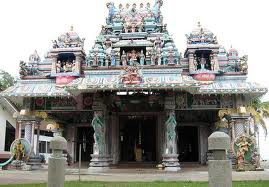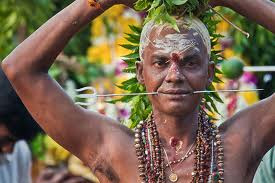
Thaipusam In Penang - A Vibrant & Colorful Festivities!
Thaipusam is an annual Hindu festival which draws the largest gathering in multi-racial Malaysia. In Penang, Murugan temple (The protector of innocent) stood majestically in the inner sanctum is the popular place on the important occasion.
The famous temple which is located atop a small hill in Penang lush Waterfall Suburbia, is visited by thousands of devotees who end their journey on foot every year. After hours of trekking from the various temples in George Town, the pilgrims ascend the hill with a final inspired spurt of fulfillment and calmness, to release their loads in the holy place as a realization of their vows.
More than 600,000 devotees and tourists converged at Waterfall yearly to celebrate or watch the annual procession of the Hindu festival. The lengthy stretch of road leading to the area, were shut completely to traffic as it teemed with throngs of people who were fringed on both sides by two lines of temporary stalls that provided refreshments, vegetarian food and religious souvenirs.
From the top of the green hill, the endless string of devotees dotting its way up the concrete steps seemed like a sacred procession of silence. They carry milk-pots of brass and silver, and harnessed in colorful kavadis and inched their way to the great temple overhead with sweet hypnotic resolve. The children, the elders and even the disabled ones, scaled slowly with their ceremonial burdens, ascending with a mission to the call of the good Lord Murugan.
It is known that the Thaipusam tradition was brought to the Malay Peninsula through the South Indian Diaspora during the 19th century. The festival has since evolved and grown so big in Malaysia and Singapore that it has now far outsized celebrations, mostly unheard of, even in India.
In actual fact, the festivities in Penang have evolved to such an extent that they assimilate distinctly local characteristics that would raise eyebrows in India. For example, the celebrations have drawn a cosmopolitan following of many non-Indians.
One group of Chinese devotees was seen pulling a small chariot of Kuan Yin, the Chinese goddess of mercy. Another group had actually prepared an ornate chariot replete with giant images of Hindu gods such as Shiva and Kali accompanied by the serene image of Kuan Yin.
However, Thaipusam is still by large inundated with Hindu rites and rituals despite few inevitable socio-cultural differences.
During the festivities, devotees spear their cheeks with long, shiny steel rods often a meter long and pierce their chests and backs with small, hook-like needles in penance. Tourists, who join the festivals, watch in awe as metal pierces the skin with hardly any bleeding and, apparently, no pain as the devotee stands in a trance in the dawn light after weeks of rigorous abstinence.
Over the years, curious British, American and Australian medical experts have come to observe and speculate. Some think the white ash smeared on the body, the juice squeezed from the yellow lime fruit or the milk poured on the pierced areas may help to numb the skin. But most admit they have no answer. The devotees say it is faith and believe in Lord Murugan is what prevents the pain and the bleeding.
For visitors, the early morning of Thaipusam is arguably the finest time to experience the purist side of the festival. The calm and tranquil march of devotees bearing ceremonial milk-pots, coconuts and simple shoulder-kavadis in the balmy hours is an interesting sight to remember.
Clad in yellow and saffron, clean-shaven heads (symbol of humility and atonement) smeared with sandalwood paste, the devotees walk along the road sans the boisterousness that dominates the later hours of the day. The pilgrim procession passes a number of temples along the Waterfall road before the ascent up to the famous hilltop temple. The usually barren rain gutters along the hillside look like slender white capillaries, flowing down with ceremonial milk offered at the temple above. Further below, a whole river has turned into an amazing canal of milk.
The festivities end on the evening when the impressive Silver Chariot bearing the image of Murugan, is slowly driven from the Sri Arulmigu Balathandayuthapani Temple in Waterfall on a long overnight journey to the Natukottai Chettiar Temple in George Town. Many observe a strict vegetarian diet for about 40 days and renounce all forms of comfort and pleasure-giving activities. The 40 days are spent in meditation and prayer.
It is interesting to note that the yearly chariot procession during Thaipusam has been held without fail since 1857. A wooden chariot was used for the first 37 years until the silver chariot was brought from India in 1894; this chariot has been used ever since.
The episode of drawing the chariot back from the waterfall temple lends an engaging atmosphere of faith, devotion and piety. Hundreds of devotees flock peacefully around the gleaming chariot, carrying trays of offerings - flowers, fruits, betel-leaves, coconuts - amid undulating music of an Indian piper and his drummer.
Little children are lifted up to the idol in the chariot for priests to invoke the deity's blessings; jasmine garlands passed along up to be placed on the idol; wisps of incense smoke, fragrance of rosewater; camera flashes and chants. All these amid a sea of devotion and equanimity.
As the chariot, pulled by bulls, slowly lunges forward, a frenzy of coconut smashing ensues before the sacred deity. Municipal council workers plunge into disciplined action, zooming a pair of bobcats and compactor units to clear the debris as the chariot moves on. During the procession, many peaceful waves of devotees wait patiently to have their glimpses of the sacred idol of Lord Murugan.
Thaipusam is also celebrated in Singapore, Thailand, Mauritius and other countries where Tamil workers migrated.


